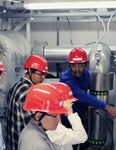USA ASEAN CHINA AUSTRALIA INDIA MIDDLE EAST - Gradiant Corporation 2020 - Gradiant ...
←
→
Page content transcription
If your browser does not render page correctly, please read the page content below
CGE SOLUTION HOW IT WORKS AT A GLANCE
Carrier Gas Extraction (CGE) is our Wastewater is sent through a heat exchanger where it is heated up before being • Novel Bubble Column Device provides efficient heat
flagship Humidification pumped into the top of a direct-contact humidifier column. Simultaneously, transfer
Dehumidification technology that ambient air enters the bottom of the humidifier. As the air rises through the
has applications for both Zero humidifier, the air and water interact resulting in evaporation. The vapor-air • Elimination of metallic evaporator and condenser
Liquid Discharge (ZLD) as well as mixture is then sent to the bottom of a multi-stage bubble column dehumidifer reduces capital cost
Brine Concentration at half the while a closed loop of fresh water is introduced to the top of the chamber. In each
cost of water as traditional stage of the bubble column, micro-bubbles are created in shallow pools of fresh • Decoupling of valuable heat transfer surface from
evaporators. water and from the surface of these bubbles condensation occurs producing the sacrificial separation surface reduces
fresh water. Heat is released in the condensation process, which is then recycled pretreatment requirement
This evaporator-alternative mimics back into the heat recovery heat exchanger to minimize the energy consumption.
nature’s rain cycle to reduce the • Thermodynamic balancing reduces energy
cost of treatment while increasing One major breakthrough of the CGE process lies in the adaptive controls which consumption
production reliability. dynamically adjust to the variation of the brine concentration, flow, and
temperature to achieve maximum water recovery and minimum opex. In • Low temperature operation allows for use of waste
The CGE system uses a carrier comparison to conventional evaporative technologies, the Gradiant CGE system heat to eliminate thermal energy costs
gas, typically air, to extract fresh uses up to 50% less energy to achieve a brine concentration of over 300,000 mg/L
water from high total dissolved TDS. What’s more, the CGE system greatly minimizes inorganic scale formation • Proprietary thermodynamic algorithm controls
solids (TDS) wastewater, within the column, dramatically lowering the cost of maintenance and eliminating operating conditions to induce precipitation in the
concentrating brines to 25% the need for harsh chemicals. humidifier and avoid scaling
salinity.CGE APPLICATIONS
Gradiant was awarded Global Water Intelligence’s “Technology Idol”
in 2013 for this groundbreaking proprietary technology and has
since installed the system for oil and gas produced water recovery,
flue gas desulfurization wastewater, petrochemicals,
pharmaceuticals, tanneries and textile wastewater recovery.
CGE products and services include:
Evaporative disposal
Brine concentration
Zero Liquid Discharge
Automated design
Mobile Services
CGE Case Study
Technology: Carrier Gas Extraction (CGE)
Capacity: 12,000 bpd (2000 m3/ day)
Products: Fresh water, clean brine, 10lb. Brine
Mobility: 2-3 months re-deployment
Treatment Requirement:
Treat 12,000 barrels per day of influent to deliver: Water
2,000 barrels per day of fresh water (TDS removal) Recovery
9,000 barrels per day of clean brine (De-oiling,
CGE RECOGNITION
disinfection, solids and turbidity control, GWI Water Technology Idol
Zero Liquid
hardness and scaling control, pH adjustment) GWI Industrial Water Project of the Year Discharge
1,000 barrels per day of 10-lb brine
Fortune 500 Customers
Over 200 Global Patents
Operation:
Clean brine TSS < 25 ppm, O&G < 25 ppm, Fe < 5 ppm Desalination
Bacteria 460 MPN/ml
Recovery ratio greater than 99.7% w/w
Solid waste produced less than 0.3% w/w
Operational Metrics:
Fresh Water Recovery at 100,000 mg/L TDS > 60%
Fresh Water Recovery at 150,000 mg/L TDS > 40%
Water quality monitored within prescribed effluent limits at all times
Solid waste disposed at appropriate landfill
All effluent reused within oil and gas operations
Utilized natural gas as energy sourceTHE CGE ADVANTAGE
PATENTED MULTI-STAGE BUBBLE COLUMN
CGE has been tested at commercial scale and has shown to be consistently lower cost than
traditional MVRs/MVCs. Learn more about this state-of-the-art technology and how Gradiant
beats the competition on cost, up-time, and sustainability.
NOVEL MULTI-STAGE BUBBLE
COLUMN DESIGN FOR DIRECT
CONTACT PHASE CHANGE
Our bubble column (BC) heat exchangers
were invented at MIT and have extremely
high heat and mass transfer rates as they
employ direct contact condensation of the
vapor-gas mixture in a column of shallow
liquid unlike traditional techniques which
condense on a cold surface. New physical
understanding of heat transfer in BCs has
led to low pressure-drop designs. The
concept of multi-staging the uniform
temperature column in several
temperature steps has led to high
effectiveness designs (about 90%). These
designs lead to significant cost
advantages for CGE over traditional
techniques like Mechanical Vapor
Compressor (MVC) distillation systems.
Gradiant has saved customers between
30-50% on total cost of water compared
to traditional evaporators through our
patented multi-stage bubble column.
Further, we as a company, are
continuously adapting and evolving our
CGE technology to meet and exceed our
customers needs.
This drive to perfect and create the most
cost effective, sustainable set of
solutions for our clients through a tailored
approach is what sets us apart from our
competitors.THE CGE ADVANTAGE
TOLERANCE TO SCALING AND PATENTED THERMODYNAMIC ALGORITHM
Proprietary
thermodynamic
algorithm controls
operating conditions to
induce precipitation in
humidifier and avoid
scaling elsewhere
THERMODYNAMIC BALANCING TO MINIMIZE THERMAL ENERGY CONSUMPTION
When finite time thermodynamics is used to optimize the energy efficiency of thermal systems, the optimal design is one which produces the minimum entropy within the
constraints of the problem (such as fixed size or cost). We applied this well-established principle, known generally as thermodynamic balancing, to the design of combined heat
and mass exchange devices (dehumidifiers and humidifiers) for improving the energy efficiency of CGE systems. This resulted in novel designs and operating procedures for the
CGE system that make it more energy efficient at treating hypersaline wastewater compared to traditional techniques like MVC. At the core of these innovations is a new non-
dimensional parameter which was invented to minimize the average local driving force for heat and mass transfer.
CHALLENGE:
The decoupling of phase change and heat transfer surfaces is crucial to
treating hypersaline water streams because of hardness scaling issues.
Scaling tendency increases with increasing salinity; the scale is likely to
form on the surface where phase change occurs. In a MVC system, the
phase change and the heat transfer occur on the same surface, resulting
in a drop in heat transfer efficiency when scale forms and acts as an
insulator.
SOLUTION:
In CGE, however, the phase change occurs in the humidifier column and
the feed water is heated in the heat exchanger. Scale forms on the
packing material in the humidifier but does not affect the evaporation or
the performance of the system because the carrier gas is in direct contact
with the hypersaline water and there is no heat transfer through the
material of the packing. Therefore, the packing material requires
significantly less cleaning or replacement as compared to a traditional
MVC system. Another benefit of having high tolerance to scaling is that
the pretreatment requirements are lower than MVC systems which further
reduces operating costs.
This integration of our patented thermodynamic algorithm for improving
energy efficiency along with a separate phase change from the traditional
MVC surfaces to prevent scaling and improve performance creates a
sustainable, energy efficient, low cost solution to your water treatment
needs.You can also read



























































